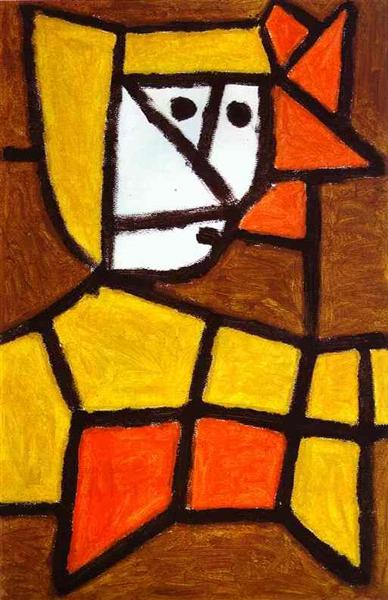Description
The work "Woman dressed as peasant" (1940) by Paul Klee is inserted in a context of artistic and emotional transformation, where the use of color and shape come together to explore the essence of the human figure in their relationship with the environment. Through an unmistakable style, Klee manages to evoke both the simplicity and the depth of rural life, reflecting a visual narrative that invites introspection.
The composition of this painting stands out for its structure based on simplified geometric shapes, a characteristic feature of Klee's work. The female figure is presented with a large circle that represents the head, contrasting with its body, much more stylized and elongated. This emphasis on the figure of women, their peasant attire and the use of soft lines, creates a sense of visual harmony, while pointing out a strong symbolism in the representation of femininity and role of women in rural society .
The color palette used is essential to understand the work. Klee opts for earthly and ocher tones, which evoke land and agricultural work, while highlighting the intrinsic connection between women and their surroundings. Warm colors encourage a sensation of closeness and belonging, suggesting that this figure is not only an isolated entity, but an ambassador of the peasant tradition, duty and resistance.
The elements of the work, although apparently simple, carry a deep symbolic load. Peasant clothing is not only a sign of cultural identity, but it can also be interpreted as a statement on the role of women in difficult times in history. In 1940, Europe was at a crossroads of conflicts and suffering; In this context, Klee, who was forced to leave his home in Germany due to Nazism, infuses his works a sense of nostalgia and search for belonging.
The use of abstract expression and the simplification of forms in "woman dressed in peasant" aligns with the exploration of modern art, where the rules of representation are blurred in favor of a search for the essence. The work is registered within the influence of expressionism and surrealism, aspects that Klee absorbed during his career and transformed into a personal style that resonated at an emotional level.
The female figure in the work reflects a duality: on the one hand, the strength of rural women, carrier of life and tradition, and on the other, the vulnerability it faces in a changing and adverse world. The juxtaposition of these qualities in the representation of the peasant women invites the viewer to reflect on their vital role in cultural continuity and resistance to adversity.
"Woman dressed as peasant" is not only a relevant work in Klee's trajectory, but is also a testimony of the power of art to capture the essence of human experience in times of crisis. Its ability to transmit complex emotions through a seemingly simple aesthetic reaffirms Klee's unique vision as one of the masters of modern art, achieving an echo that resonates with the concerns of his time and that remains relevant today.
KUADROS ©, a famous paint on your wall.
Reproductions of paintings handmade oil, with the quality of professional artists and the distinctive seal of KUADROS ©.
Art reproduction service with satisfaction guarantee. If you are not completely satisfied with the replica of your painting, we refund your money 100%.

